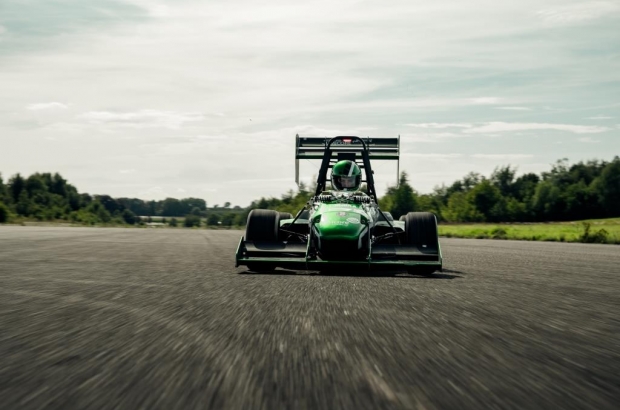- Daily & Weekly newsletters
- Buy & download The Bulletin
- Comment on our articles
Electric race car combines green innovation with ultimate performance
Last year’s race car built by Formula Electric Belgium was among the fastest in the world. This year, a team of 37 engineering students from KU Leuven and Thomas Moore University have come together to build a worthy successor.
For now, it is only a digital prototype, but when it’s complete, the car will boast a sleek aerodynamic design and an entirely electrical engine. Dubbed “Umicore Isaac” after one of the team’s sponsors and the famed English scientist, the racer should be ready by June. It will then depart for Formula Student, the largest student competition in the world.
Races will take place on actual Formula One circuits, which include the Silverstone in the UK, Hockenheimring in Germany and the Circuit de Barcelona-Catalunya in Spain.
In 2015, the car’s predecessor “Umicore Luna” (pictured) finished fourth in the overall ranking. Although the students are confident about this year’s design, the challenge won’t be easy. Some 600 other schools are currently working on their own prototypes.
The competition is part of a postgraduate programme on innovation and entrepreneurship that’s offered at most Flemish universities. As part of their curriculum, students are allowed to work on an entrepreneurial project of their choosing – with little to no supervision from instructors.
From 0 to 100
How difficult is it to build an electric race car? “The real challenge lies not in constructing one but in ensuring that it achieves a good performance on the track,” says Andreas Wauters, manager of the Flemish team. The students have already designed a 3D prototype, so they can figure out all the elements before construction begins.
Once it’s finished, the car will weigh 200 kilograms and produce upward of 160 horsepower. That’s nearly five times less than the typical Formula One race car, but Umicore Isaac will be able to accelerate from 0 to 100 km/h in just 2.7 seconds, leaving most conventional road vehicles in the dust.
There is just one trade-off. The car has a limited range of 22 kilometres, so for longer distances, it will need extra power. “We will have to put additional batteries on board,” Wauters says. “This of course increases the weight, which in turn lowers the overall performance.”
The short range won’t be an issue in the upcoming summer races. “The jury will judge each car on several merits,” explains Wauters. “The actual performance in the race is just one of them.”
For safety reasons, the cars will also not be allowed to race together. “And we can’t use professional drivers,” Wauters adds. “The technology is the focal point here, not the driving abilities. Only the students – at least those with a driving licence – will be at the wheel.”
Every team can earn a maximum of 1,000 points. Up to 300 points are given during an off-track inspection, in which the design, the appearance and comfort are rated. The remaining 700 points are allotted in tests, which include acceleration and endurance, but also how the car handles on the curves.
The Flemish team has chosen to focus on performance and reliability. It has developed an active suspension system that dampens wheel movement, which should result in improved ride quality and handling. The prototype is also aerodynamic for better grip on the track.
Wauters: “We call these improvements a marriage between green innovation and performance.”
Photo courtesy of Formula Electric Belgium









